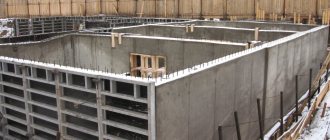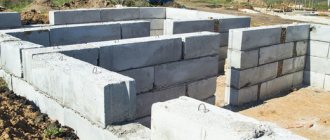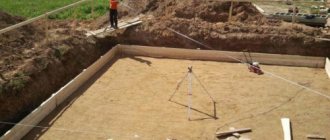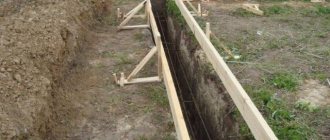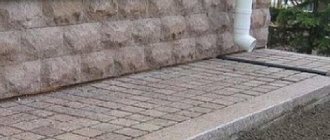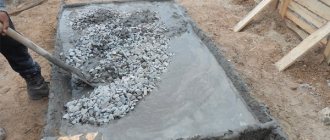Material rating
20 out of 5 Easy to use
20 out of 5
Environmental friendliness
20 out of 5
Price
16 out of 5
Appearance
20 out of 5
Practicality
final grade
4.8
4.8 out of 5
The foundation is the foundation of the house, and therefore requires careful and careful work on its installation. The more important and massive the building under construction, the stronger and better quality the foundation should be. An important role is played by the components of the foundation, the properties of which fundamentally affect the operational parameters of the house.
Construction crushed stone is a universal material for laying foundations
Most commonly used types of foundations fundamentally consist of two parts - a fill substrate and a stone base.
The substrate (pillow) performs the function of uniformly distributing the pressure of the house over the ground. Compensation for temporary soil unevenness with the loose part of the cushion prevents deformation of the building.
The quality of the substrate directly affects the maximum supported weight. The stronger the materials in its composition, the less shrinkage of the house will be and the accompanying negative consequences - cracks and distortions, up to the complete destruction of the structure. All construction work using crushed stone is regulated by GOST.
Which crushed stone is best for the cushion and foundation of a house depends on the features and height of the future building. In most cases, crushed gravel is used for cushioning and preparing concrete. The granite variety is used for the most critical and heavy structures.
Options for crushed stone fractions and the main purposes of its use in solution

Various types of crushed stone fractions are used for concrete under the foundation. The size of the material affects the strength characteristics of the building and more. More about this:
- For medium-sized future buildings, fine crushed stone is used, which can be used independently;
- Crushed stone of medium-fraction characteristics is used for massive structures. It will definitely need to be mixed with fine material;
- Large crushed stone is used only for laying large buildings. Most often these can be multi-story structures.
When using fine crushed stone, you should be careful and vigilant. When the diameter of the grains is less than five millimeters, the material can no longer be considered crushed stone; it is rather sand, the use of which significantly reduces the strength characteristics.
Types of foundation substrates using crushed stone
Sand-crushed stone cushion having sufficient strength to support a building of several floors. The most common application is the construction of large private residential buildings and cottages.
The sand-crushed stone cushion is a two-layer structure - the bottom layer consists of sand, and the top layer consists of crushed stone. It is their combination that makes it possible to increase the permissible load and increase the weight and dimensions of the building.
Two layers of materials act as a consistent mediator of pressure from the building to the ground. Crushed stone is not as prone to crushing and leaving the base as sand, so it bears the main load.
The sand under the crushed stone has a larger area of contact with the gravity of the house, and is therefore less susceptible to its effects. Better distributed load increases the strength properties of the cushion when compared with the sometimes used single sand layer. The standard thickness of the substrate is 30-35 cm, of which 20-25 cm is crushed stone.
Concrete pad. Despite the name, the concrete layer is not laid directly on the ground, otherwise numerous subsidences will significantly reduce its strength. Under the cast concrete slab there must be a backfill of crushed stone.
The purpose of the bedding is to level out minor subsidence and improve the adhesion of the foundation to the soil. The more the shape of the crushed stone differs from the correct one, the better the grip will be.
The thickness of the crushed stone backfill is typically 10-15 cm, and the thickness of the concrete pad layer is 25-30 cm. The concrete base should protrude 15 cm beyond the boundaries of the future foundation in order to achieve maximum stability of the house.
In the video, a trench under the foundation has already been filled with crushed stone:
Advantages of a crushed stone pillow
The choice of a cushion made of crushed stone is due to the impressive mass of the future building and better performance characteristics compared to sand . Just like the latter material, crushed stone perfectly withstands temperature changes and has outstanding drainage and thermal insulation qualities. When constructing a crushed stone cushion, a topping layer of sand is used, the construction of which is no different from creating a sand base, but its layer is much smaller. It is not critically different from the sand and crushed stone pillow. In accordance with the project, the required thickness of the crushed stone layer is placed in the prepared trench and compacted.
Compaction is necessary to eliminate voids and ensure that the parts fit together as tightly as possible. It has the following disadvantages. More expensive than sand, it is not available in all areas , meaning transportation adds price to the product. Crushed stone comes from gravel, granite, and limestone. The first is durable and radioactively neutral.
It is mined by sifting rocks or crushing stones in crushers. It has a low cost. The second is obtained by processing granite, is extremely durable, and is used in civil engineering. Limestone is the most unpretentious type, obtained from limestone rocks, and lags behind the two previous types in strength.
Return to content
Preparing the soil for the foundation - general rules
Numerous types of soil, as well as various weather conditions, influence the composition and technology of laying the foundation. For accurate calculations in construction, a number of rules, formulas and reference values are used to determine the required parameters of the materials and work used. In addition, when constructing buildings, they are guided by GOST standards for building crushed stone.
- The foundation is never installed on black soil. Even during the construction of non-critical buildings (shower stall, toilet or storage room for equipment), a foundation located on top of black soil will cause a dangerous distortion of the entire structure in a few years. The fertile and unstable layer of soil is small in thickness - up to 30-50 cm. Removing it manually is not difficult, but it will reliably protect you from negative consequences.
- The surface of the foundation pit or trench must be horizontal. The reason lies not only in the excess consumption of materials when leveling the slope, but also in the strength gradient of the resulting substrate. In its thinnest place, defects are most likely to occur.
- To prevent the transition of sand from the bottom of the substrate into clay, it is desirable to use geotextile materials.
- The time interval between excavation and laying of the foundation should not be prolonged. Otherwise, the work will be hindered by the soil, which constantly rolls into a pit or trench when it dries.
- The compaction of the cushion under the foundation should be done using a special vibrating plate, also called a “vibrating heel”. After compaction, you can walk on the crushed stone bed without disturbing the surface.
These tips are universal for any type of soil and building under construction. Failure to comply with them entails a deterioration in the quality of the building and a decrease in its strength characteristics.
Which crushed stone to choose
When using this building material, the following factors are taken into account:
- Soil composition on the site;
- Foundation dimensions;
- Soil freezing depth;
- Proximity of groundwater.
Chernozem, soft sandy soils shrink and this causes the house to sag. It is better to take crushed stone of different fractions and lay it in 2 layers.
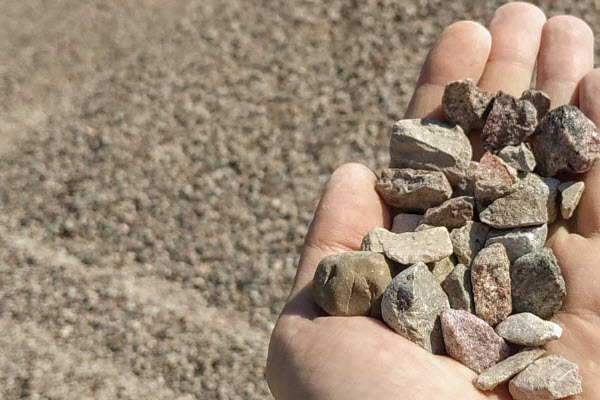
For cushions for low-rise buildings, a fraction of 20-40 mm is often used. It has a high degree of void filling and is easy to compact. Finer gravel is laid down, and larger gravel is placed on top. The strength of the material should be M800-M1200, frost resistance - F300-F400.
To prevent the foundation from being modified, it is better to form the pillow from crushed granite stone. It is more expensive than other types, but can withstand the load of any structure. More often it is combined with sand.
Preparation of concrete for the foundation - proportions of components
The use of crushed stone is not limited to bedding in the manufacture of the base. The slab foundation contains crushed stone in the concrete, which gives the required strength and reduces overall costs.
Concrete is a mixture of cement, sand and crushed stone (or its substitutes), which is obtained after they are mixed with water and undergo a “setting” process. Reinforced concrete contains metal mesh or reinforcement bars, which impart significant strength.
For the production of reinforced concrete, the average fraction of crushed stone with a particle size of 20-30 (maximum 40) mm is suitable. A larger stone will not be evenly distributed throughout the volume of concrete. As a result, stress concentrators are formed - weak points of the concrete slab that are susceptible to destruction.
Non-reinforced concrete does not require the use of narrow-graded crushed stone and can contain larger stones. To sift crushed stone or sand-crushed stone mixture, meshes with cells of appropriate sizes are used.
For an ordinary unreinforced foundation, concrete grade M100 (higher is possible) is sufficient, and for a shallow foundation - M150. The optimal ratio of sand to crushed stone in a sand-crushed stone mixture is 2 to 1. It is recommended to mix cement and sand-crushed stone mixture in a ratio of 1 to 6 (for M500 cement) or 1 to 5 (for M400 cement).
Preparation of the solution and the necessary proportions of materials for the foundation using crushed stone:
Main characteristics of crushed stone
There are many varieties of crushed stone, which differ in their basic characteristics, which include:
- Material of manufacture.
- Factionalism.
- Strength.
- Frost resistance.
- Flakiness.
- Cleanliness of building materials, including environmental ones.
To decide on the choice of material, you need to have more detailed information about all of the above parameters.
You can also use a calculator to calculate the amount of sand and gravel mixture for a foundation cushion with explanations for the work.
Materials for making crushed stone
First of all, what is hidden under the name crushed stone? This is a bulk material of inorganic origin, obtained by crushing large rocks or waste, followed by sieving into fractions. According to established domestic standards, the minimum grain size is 5 mm, according to European standards – 3 mm.
Crushed stone for foundation construction is made from different raw materials obtained from various sources. Therefore, they can be divided into groups:
- Rocks with the most dense structure.
- Waste remaining during the processing of rocks and the operation of mining and processing enterprises.
- Industrial waste (slag) from metallurgical production and thermal power plants.
- Concrete structures recycled after dismantling old buildings or after discarding.
Prices for crushed stone
Crushed stone
Crushed stone, depending on its origin, is divided into the following most commonly used varieties:

Granite crushed stone is certainly the most optimal option for pouring foundations
- Granite crushed stone , as the name implies, is made from solid rock - granite. This mineral is made up of feldspar, mica and quartz, which have been shaped into hard rock blocks over many hundreds of years. Due to the presence of feldspar inclusions in granite, the stone acquires different shades. It can be green, blue-gray, red, pink, gray, ocher and others. By these shades and characteristic granular structure, you can immediately determine that this is crushed granite stone.
Crushed stone of various fractions is obtained from granite as a result of its crushing. To separate it into fractions, the crushed material is sifted through grates having cells of different sizes.
Granite crushed stone is definitely the best option for arranging the foundation for a house and for creating other heavily loaded reinforced concrete structures.

Limestone crushed stone is cheap, but is of little use for critical foundations
- Crushed limestone is made from sedimentary rocks, which mainly consist of calcite. Large limestone stones also undergo a process of crushing and sorting into different fractions.
This material is not recommended for use as a cushion for the foundation of massive residential buildings, nor is it recommended to be added to the mortar for pouring it. Limestone simply does not have sufficient strength due to its mineral composition, and in addition, over time it is susceptible to erosion and disintegrates.
The only advantage of crushed limestone is its low price. This material is only suitable for arranging the base of light wooden buildings that will not create high loads on the foundation.
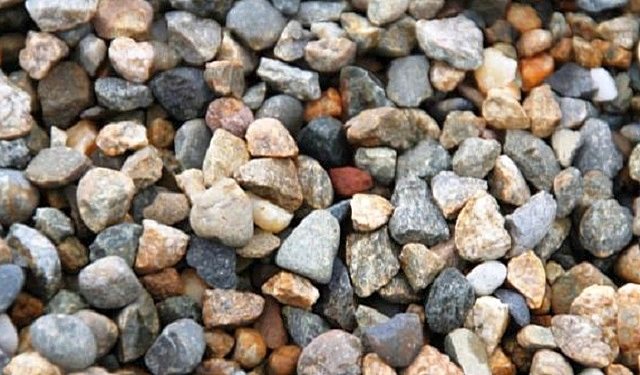
Crushed gravel - suitable for pouring a foundation, but taking into account some nuances
- Crushed gravel is obtained by crushing large stone boulders of sedimentary rocks, or is mined in the process of sifting quarry soil. This type of crushed stone also includes gravel of a larger size than ordinary pebbles, which is formed in bottom sea and river sediments.
Crushed stone, which is produced by crushing, has approximately the same parameters as granite, although it is somewhat inferior in terms of strength. But this pays off with a lower price and an almost complete absence of the likelihood of a radioactive background.
Ordinary gravel differs from it in having rounded edges and more neat shapes. Due to the fact that natural gravel does not have sharp corners, when it is used to make mortar, the adhesion of the components during maturation and strength gain will be significantly lower than when using crushed crushed gravel.
However, rounded natural gravel is perfect for arranging a foundation cushion, as well as for use in landscape design, as it has picturesque natural shades - from black to yellow, from pink to gray-blue. Moreover, with different lighting and humidity levels, the colors of the stones may change.

Slag crushed stone is well suited for casting various reinforced concrete structures. But for the foundation - hardly...
- Slag crushed stone is obtained by crushing and subsequent sorting of waste from metallurgical enterprises. The material is not particularly expensive, which means it attracts the attention of consumers. But when using it, special caution is required regarding the declared physical and technical characteristics.
The fact is that slag can have a different structure, chemical composition, density and other indicators that can negatively affect the strength qualities of concrete. Some of these types of crushed stone are excellent for mixing light mortars, but their use for foundations will be unacceptable. Often, slag has a very aggressive chemical structure that is unsafe for steel reinforcement parts. Often, metallurgical waste also has a somewhat elevated background radiation.
Prices for PShchS
psshh
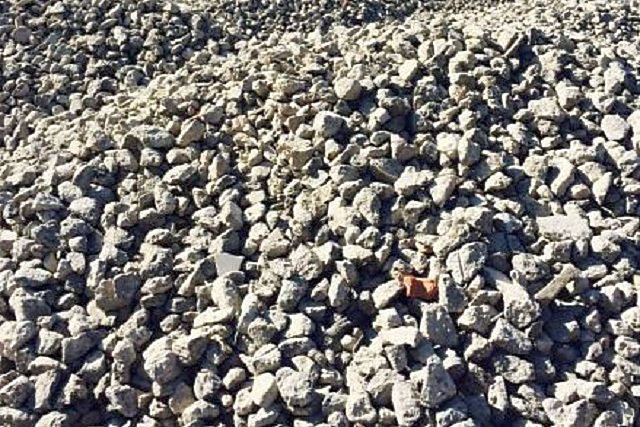
Old concrete structures that have been dismantled or rejected during production are recycled and used to produce concrete crushed stone.
- Concrete crushed stone is obtained by recycling old, previously used or discarded concrete structures. Therefore, its cost is approximately half that of granite.
It would seem that this is the best option. Quite affordable price, “concrete to concrete”. That is, it seems to be full compatibility... However, not everything is so simple. In terms of strength indicators, recycled concrete crushed stone is significantly inferior to natural materials. It is not used for mixing solutions with grade strength above M200. And even in road construction, its use is permitted only for highways that do not have federal status.
But for strengthening unstable soils, for backfilling paths and platforms, for cushioning under foundations, for casting lightly loaded reinforced concrete structures, such material is quite suitable. Including for, for example, the foundations of utility or other light buildings.
To use such material for residential construction, you must be sure that the concrete products from which the crushed stone is made were previously used in environmentally friendly areas and were not exposed to radiation. If crushed concrete is of unknown origin, its characteristics are not reflected in the accompanying documentation (which simply does not exist), it is better to refuse to purchase it.
Recycled crushed concrete must not contain glass, brick, wood, ceramics, insulation or finishing materials. Such crushed stone can be classified as the first grade of this type of material.
In second-grade crushed concrete, weed inclusions are allowed in an amount of 1÷7% of the total volume.
Fractionality of crushed stone
Crushed stone made from any materials is divided into fractions, that is, it can have different stone sizes. As mentioned above, the total crushed mass is subjected to sorting - fractionation: the crushed stone is passed through special sieves, eloquently called a “screen”.
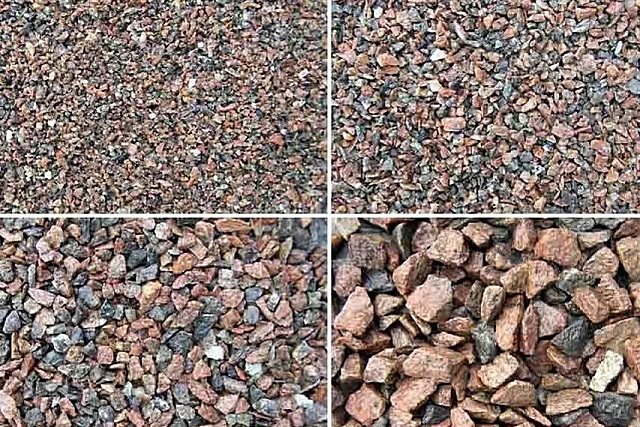
After crushing, crushed stone is sorted by grain fractions
Crushed stone fractions are divided into standard and non-standard.
- The first of them include the following parameters of the stone, which are usually counted in millimeters: 40÷80; 20÷40; 15÷20; 10÷15; 5÷10; 3÷8 (European standard).
- Non-standard fraction options include those sizes of crushed stone that are manufactured according to the consumer’s order. Thus, the sizes of stones can reach very impressive figures, for example 80÷120 and even 120÷150 mm.
In addition, fractional screenings of crushed stone ranging in size from 0 to 20 and from 0 to 40 mm are actively used in construction.
Strength of building crushed stone
The strength grade of crushed stone is determined experimentally. To do this, tests are carried out, which consist of exposing the stone to high compressive loads, simulating the pressure of moving rollers used in road construction, crushing and abrasion when it is scrolled in a drum.
As a result of past tests, crushed stone is assigned a certain grade:
- M1200 and M1400 are high-strength building materials.
- M800 and M1200 - durable crushed stone.
- M600 and M800 - average strength of crushed stone.
- M300 and M600 - low strength.
- M200 - very low strength.
For arranging a cushion under the foundation of a residential building, M800 crushed stone, which has medium strength, is most often used, and for pouring the foundation base, high-strength M1200 crushed stone. If it is necessary to build a lighter structure, for example, a fence or a shed, then the M800 or M800 brand of building material is most often used.
It should be noted that recycled crushed concrete has only three strength grades: M600, M400 and M300. This is no more proof that this material is of little use for foundations.
Crushed granite and gravel have the maximum strength parameters. The lowest indicator is for limestone and some slag crushed stones.
Frost resistance of crushed stone
The frost resistance of building materials is measured in the number of cycles that they can withstand without any loss of their physical and operational characteristics. A cycle is the process of complete freezing and thawing of crushed stone or any other building material. There is a special designation for this indicator - the letter “F” (from the English “frost” - “frost”). This parameter of building materials is also determined on the basis of experimental laboratory tests.
So, the frost resistance of crushed stone made from different materials is:
- Granite crushed stone - F300÷F400.
- Limestone - F25÷F100.
- Gravel - F200÷F300.
- Concrete - F50÷F75.
- Slag - F75÷F200, depending on the composition of the remelt.
The share of pouring critical building reinforced concrete structures, which include loaded foundations, is usually crushed stone with a frost resistance index of at least F250-300.
Flakiness of crushed stone
One of the most important specific parameters of crushed stone is flakiness. This is an indicator that displays the percentage of stones having different shapes.
Cement prices
cement

One of the important parameters of crushed stone is its flakiness. This concept refers to the predominant shape of the stones
The illustration above shows the shape of the stones that can make up the total mass of building rubble:
a) - cubic grain,
b) - an acute-angled stone,
c) - wedge-shaped crushed stone,
d) - flaky.
Thus, the mass of crushed stone produced by any method and from any material always contains plate-shaped and needle-shaped stones (grains). Needle-shaped elements include those whose length is more than three times their width, and lamellar elements are fragments that have a thickness that is a second or more less than their length.
The flakiness indicator indicates the content of such needle-shaped and lamellar stones in relation to the total volume of crushed stone. It should be noted that the lower the flakiness index, the higher quality the material is considered. Cuboid grains always have greater strength, and concrete based on them is the most dense and homogeneous, with minimal gaps between the filling fragments.
At the same time, the production of such cube-shaped grains is the most complex and costly. This predetermines the high cost of such material. Therefore, expensive types of crushed stone with the lowest flakiness are usually used for particularly critical construction sites.
Granite crushed stone has the most optimal flatness characteristics for building a foundation for a residential building. When it is crushed, almost all the grains are of the correct shape, suitable both for arranging a pillow under the foundation and for mixing the solution.
Prices for PGS
pgs
So, in terms of flakiness, according to GOST standards, crushed stone is divided into five groups:
- First group . This group includes crushed stone that is mainly cuboid in shape, and the number of grains with an undesirable shape does not exceed 10% of the total mass. Such parameters are typical for well-processed granite crushed stone, which is excellent for creating a foundation for a residential building.
- The second group is called “improved”. It includes building materials, the mass of which contains from 10 to 15% of stone of substandard shape. Such characteristics also apply to crushed granite crushed stone, which is quite suitable for building a foundation.
- The third group may contain from 15 to 25% fragments with shapes that do not correspond to the stones of the bulk of the building material. These parameters are more typical for crushed stone made from limestone rocks.
- Fourth group. Crushed stone belonging to this group may contain from 25 to 35% substandard stone. It must be said that both the third and fourth groups of crushed stone in terms of flakiness do not provide the solution with a sufficient level of adhesion. Therefore, these options are not suitable for making a foundation, but can be used to create a pillow for it.
- The fifth group contains from 35 to 50% grains that do not correspond to the normal forms of crushed stone. This material is considered low-grade, so it is practically not used in capital construction. Such crushed stone is used in the construction of light or temporary buildings or in the creation of roads that are not particularly loaded.
Failure to comply with the recommendations for choosing crushed stone based on flakiness leads to the fact that products in which substandard material was used do not differ in strength and durability. Over time, concrete parts, under aggressive environmental influences, lose their strength, delaminate, erode, and crumble.
From the recommendations given above, it follows that crushed stone belonging to the first or second group in terms of flakiness is suitable for building the foundation of a residential building. Only with such a concrete filler is the foundation of the building guaranteed to cope with its functions.
Radioactivity indicator
An important criterion when choosing crushed stone for building a foundation is its environmental friendliness. And most often this concerns the indicator of radioactivity of the material, since background radiation is detected in some types of stone or industrial waste. This factor is due to the fact that the rocks from which crushed stone is produced may contain natural radionuclides such as cesium, thorium, uranium and others in small quantities.
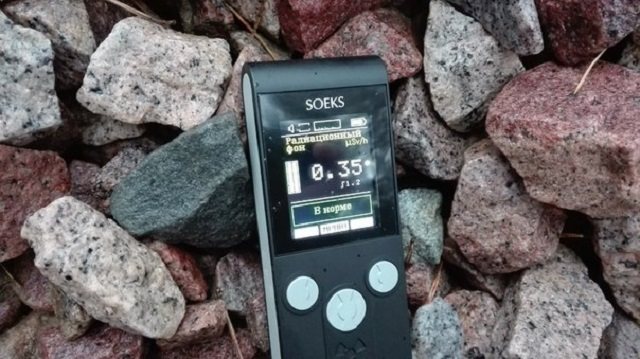
It is never a bad idea to inquire about the background radiation level of natural building materials. It happens that it is clearly overpriced.
Most often, the manifestation of such a background is quite insignificant, so most consumers are worried about this. However, when purchasing bulk building materials, it is still worth checking the certificate, which should be available from the seller. Taking care of your own health should always come first.
Certificates and sanitary-epidemiological reports must indicate the category of material in terms of radioactivity.
Thus, for the construction of public and residential buildings, crushed stone can be used with an indicator of no more than 740 Bq/kg for non-residential buildings.
According to this parameter, crushed stone is divided into three classes:
- The first class of crushed stone (radioactive background level no more than 370 Bq/kg) is fully used for housing construction without any restrictions.
- The second class (up to 740 Bq/kg) is applicable for the construction of road surfaces, including in populated areas.
- The third class (over 740 Bq/kg) is used for the construction of roads passing exclusively outside populated areas.
Purity of crushed stone
It is probably unnecessary to explain that the cleaner the crushed stone, the better quality it is. But its bulk composition most often includes third-party materials. Some of them are simply unnecessary “ballast”, but there are others that can seriously reduce the quality of future reinforced concrete products. This aspect also needs to be given increased attention when choosing crushed stone. The quality certificates for a batch of crushed stone must reflect the percentage of impurities and their compliance with standards.

Conscientious sellers of building materials must have a copy of its quality certificate for each batch of crushed stone. This document reflects all the main characteristics of the material.
The composition of high-quality crushed stone should not include components that will provoke corrosion processes, since it will come into contact with the metal elements of the reinforcement frame, as well as with embedded parts. When mixing solutions, inclusions harmful to the strength and durability of concrete, such as:
- Clay minerals.
- Asbestos fibers.
- Organic components - acids, coal, oil shale.
- Mineral substances capable of weathering - apatites, chlorites, phosphorites, etc.
Sand prices
sand
The following components, which may be part of crushed stone, also reduce the quality of the concrete monolith and cause corrosion processes on the reinforcement frame: mica (in a free state), sulfur-containing and halogen-containing minerals, gypsum, layered silicates and iron oxides.
These substances may be present in rocks in the volume established by regulations, but no more. Their permissible quantity, depending on the degree of harmfulness, varies and can range from 0.1 to 15% of the total volume of building material.
Basics of concrete pouring technology for foundations
The steps for preparing a concrete pad, as well as the base, include the following:
- installation of formwork (flat boards) limiting the shape of the concrete mixture. There should be no gaps in the formwork below through which concrete can leak. Otherwise, the formwork will rise, which will lead to a change in the shape and size of the cast slab;
- preparation of concrete solution produced in a concrete mixer. It is impossible to prepare the mortar manually, as is common when laying walls, for large volumes of work. The reason is the deterioration in quality due to uneven manual mixing, as well as the lack of solidity of the future slab;
- pouring concrete into forms limited by formwork. It is recommended to cover the resulting layer with a polymer film to prevent rapid hardening.
Setting of concrete occurs within 2 weeks. During the first week, it is advisable to moisten the hardening solution with water - this way you can avoid drying out and cracking.
Garden paths made of crushed stone - nothing could be simpler
Being a universal building material, crushed stone is used to form a variety of bedding – from dirt roads to laying garden paths. Let's look at how you can lay crushed stone paths with your own hands and what you need for this.
The stages of work are as follows:
- marking the boundaries of the path, the bend lines of which can be fixed with a handy tool - a garden hose for watering;
- preparing a small trench with a flat bottom, 15-20 cm deep, in a marked area. The soil is thrown to the side (chernozem) or carried out in buckets or on a tarpaulin (clay);
- cleaning the bottom of the trench from plant debris. After cleaning, the surface is treated with a herbicide, otherwise in a year or two you will have to constantly break through the grass growing in the middle of the path;
- covering the bottom of the trench with a polymer film or agro-fabric. The edges of the material are fixed with edging, sold in hardware stores, or with curb stones. The edging and curb should protrude slightly above the ground surface (1-1.5 cm) to minimize the mixing of crushed stone and the surrounding soil.
- filling the inside of the path with a mixture of fine crushed stone (can be broken stones or stone dust) with clay, which is watered with water and then compacted. The height of the formed layer (pillow) after compaction should be 10-15 cm;
- An outer “finishing” layer of crushed stone is poured on top of the pillow, the optimal thickness of which is 5-7 cm. To improve its appearance, you can add river or sea pebbles, as well as pieces of colored slates.
Once a year, the path should be updated by adding some new crushed stone or other materials. If the path becomes boring or shows its impracticality, you can lay paving slabs on top of it or make a cast concrete screed.
Examples of garden paths made of crushed stone
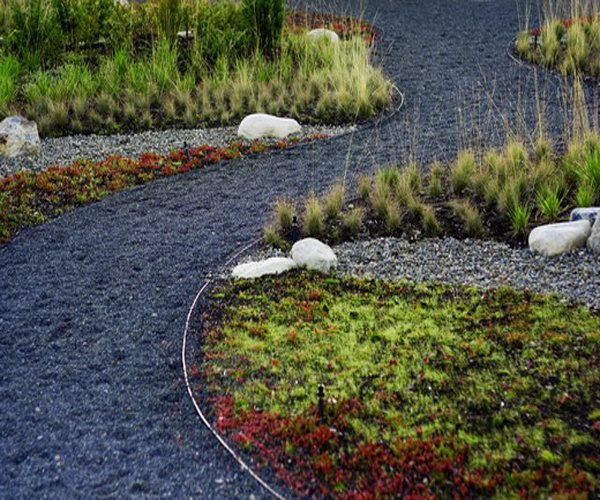
crushed stone garden path
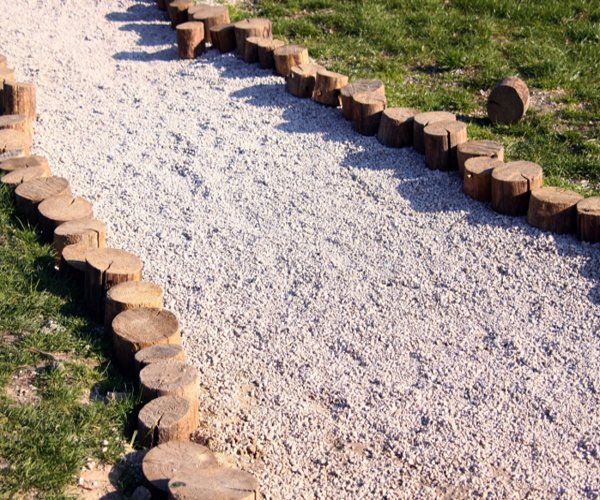
crushed stone garden path

crushed stone garden path
Types of crushed stone brands
Crushed stone is produced:
- from granite and granite-like rocks;
- from gravel;
- from limestone rocks;
- from slag;
- from recycled materials.
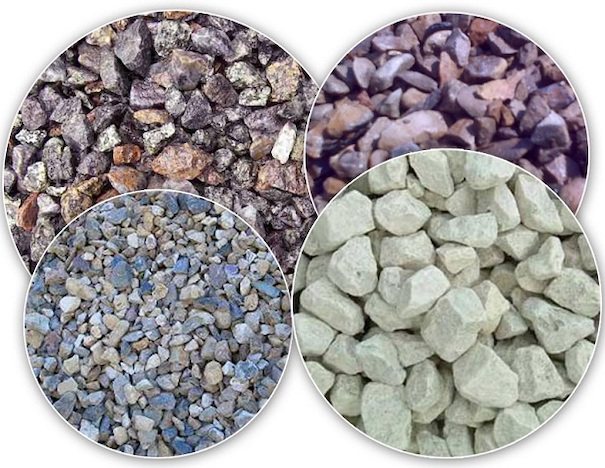
Crushed stone grades and characteristics are assessed by the reaction of the grains of each material to the impacts produced. The following grades of crushed stone are regulated by standards:
Advantages and disadvantages of crushed stone - performance properties
Crushed gravel is a strong and durable building material. It existed in nature long before the house was built and will exist long after its demolition. The simplicity and ease of use of the material, as well as its practicality, deserve the maximum rating of “5”.
Prices for crushed stone per m3 fluctuate within a wide range. Offers of recycled, cheaper raw materials allow significant savings during large-scale construction. Since there is a good choice in the price range, crushed stone also gets a “5” for the price.
The appearance of crushed stone in concrete is difficult to assess, but in paths it has to be embellished with pebbles or slate. The material gets a “4” for its appearance.
Crushed stone is a necessary component in any construction. The parameters of the buildings being built largely depend on its characteristics and quality.
The more expensive the crushed stone, the higher the strength of the house. Do not forget that greater strength is required for massive multi-story structures. For country houses, the only effect of excess strength will be a significant overpayment.



